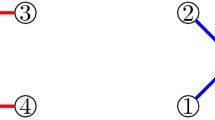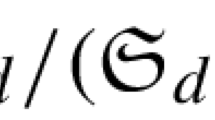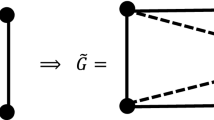Abstract
In this paper, we introduce a determinant-like map \(\mathrm{det}^{S^3}\) and study some of its properties. For this, we define a graded vector space \(\Lambda ^{S^3}_V\) that has similar properties with the exterior algebra \(\Lambda _V\) and the exterior GSC-operad \(\Lambda ^{S^2}_V\) from Staic. When \(\mathrm{dim}(V_2)=2\), we show that \(\mathrm{dim}_k(\Lambda ^{S^3}_{V_2}[6])=1\), which gives the existence and uniqueness of the map \(\mathrm{det}^{S^3}\). We also give an explicit formula for \(\mathrm{det}^{S^3}\) as a sum over certain 2-partitions of the complete hypergraph \(K_6^3\).






Similar content being viewed by others
Data availability
The datasets generated during the current study are available from the corresponding author on reasonable request.
References
Bretto, A.: Hypergraph Theory: An Introduction. Springer, New York (2013)
Carolus, S.: Properties of Higher Hochschild Cohomology, Ph.D thesis (2019)
Carolus, S., Staic, M.D.: G-algebra structure on the higher order Hochschild cohomology \(H^{\ast }_{S^2}(A, A)\). Algebra Colloq. 29(1), 113–124 (2022)
Cremona, L.: Elements of Projective Geometry, Translated by Charles Leudesdorf, 2nd edn. Oxford at the Clarendon Press (1893)
Lippold, S., Staic, M.D., Stancu, A.: Edge partitions of the complete graph and a determinant like function, ar**v:2102.09422, to appear in Monatshefte für Mathematik
Pirashvili, T.: Hodge decomposition for higher order Hochschild homology. Ann. Sci. Ecole Norm. Sup. (4) 33, 151–179 (2000)
Staic, M.D.: The Exterior Graded Swiss-Cheese Operad \(\Lambda ^{S^2}(V)\) (with an Appendix by Ana Lorena Gherman and Mihai D. Staic), ar**v:2002.00520
Staic, M.D., Van Grinsven, J.: A Geometric Application for the \(det^{S^2}\) Map. Comm. Algebra 50 (3), 1106–1117 (2022). https://doi.org/10.1080/00927872.2021.1977946
Sturmfels, B.: Algorithms in Invariant Theory. Springer, New York (2008)
Voronov, A.A.: The Swiss-cheese operad. Contemp. Math. 239, 365–373 (1999)
Weibel, C.A.: An Introduction to Homological Algebra, vol. 38. Cambridge University Press (1995)
Acknowledgements
We thank Alin Stancu and Jacob Van Grinsven for some comments and discussions. We also thank the anonymous referee for feedback that helped us improve the presentation.
Author information
Authors and Affiliations
Corresponding author
Additional information
Publisher's Note
Springer Nature remains neutral with regard to jurisdictional claims in published maps and institutional affiliations.
Appendices
Appendix A: An explicit formula for \(\mathrm{det}^{S^3}\)
It follows from Lemma 4.5 that the map \(\mathrm{det}^{S^3}\) is invariant under the action of \(SL_2(k)\) on \(V_2\). From the general results of invariant theory (see [9]), it follows that \(\mathrm{det}^{S^3}(\otimes _{1\le i<j<k\le 6} (v_{i,j,k}))\) can be written as sum of product of determinants of two by two matrices with columns consisting of the vectors \(v_{i,j,k}\). In this section, we give an explicit formula for \(\mathrm{det}^{S^3}\). This is also an alternative proof for the existence of the map \(\mathrm{det}^{S^3}\).
For two vectors \(u=ae_1+be_2\) and \(v=ce_1+de_2\), we denote by [u, v] the determinant of the matrix that has the first column equal to u and the second column equal to v, that is,
Proposition 5.1
Let \(v_{i,j,k}\in V_2\) for all \(1\le i<j<k\le 6\), then we have




Proof
We denote by \(B(\otimes _{1\le i<j<k\le 6} (v_{i,j,k}))\) the right-hand side of the above equality. In order to prove \(B=\mathrm{det}^{S^3}\), one can use the universality property of the \(\mathrm{det}^{S^3}\) map. It is easy to check that \(B(\omega _{{\mathcal {P}}^{(1)}})=1\).
Next, we want to show that if \(\otimes _{1\le i<j<k\le 6}(v_{i,j,k})\in V_2^{\otimes 20}\) such that there exist \(1\le x< y<z<t\le 6\) with the property that \(v_{x,y,z}=v_{x,y,t}=v_{x,z,t}=v_{y,z,t}\), then \(B(\otimes _{1\le i<j<k\le 6}(v_{i,j,k}))=0\).
First, notice that B is invariant under the action of the subgroup \(G\subseteq S_6\) that is generated by (2, 3), (3, 4), (4, 5), and (5, 6). Because of this fact, it is enough to check the universality property for \((x,y,z,t)=(1,2,3,4)\), and for \((x,y,z,t)=(2,3,4,5)\).
Case I If \((x,y,z,t)=(1,2,3,4)\), then \(v_{1,2,3}=v_{1,2,4}=v_{1,3,4}=v_{2,3,4}\). It is easy to see that all the terms in \(B(\otimes _{1\le i<j<k\le 6}(v_{i,j,k}))\) are equal to 0; for example, the first term is equal to zero because \([v_{1,2,3},v_{2,3,4}]=0\).
Case II If \((x,y,z,t)=(2,3,4,5)\), then \(v_{2,3,4}=v_{2,3,5}=v_{2,4,5}=v_{3,4,5}\). Let \(v=v_{2,3,4}=v_{2,3,5}=v_{2,4,5}=v_{3,4,5}\). In this situation, all the terms will cancel in pairs. For example, if we look to the first term and thirty-seventh term, we have the following expressions, respectively:
and
So, we get these terms to sum up to zero. The rest of the matching pairs are given in the following table:

One can see that the pairs of terms have opposite signs. So, all the terms will cancel in pairs, which proves our statement. \(\square \)
Appendix B: Equivalence classes of 2-partitions under the \(S_6\times S_2\) Action
As discussed earlier in the paper, there are 184,756 homogeneous 2-partitions of the hypergraph \(K_6^3\). Using MATLAB, one can show that 13,644 of them are nontrivial (see Lemma 4.6). We also know that there is an action of the group \(S_6\times S_2\) on \({\mathcal {P}}_2^{h,nt}(K_6^3)\). In this section, we present the 20 equivalence classes of \({\mathcal {P}}_2^{h,nt}(K_6^3)\) under the action of \(S_6\times S_2\) and the value of \(\varepsilon ^{S^3}_2\) on each element in \({\mathcal {P}}_2^{h,nt}(K_6^3)\). All results in this section were obtained using MATLAB.
A summary of this information is presented in the following table, where \({\mathcal {P}}^{(i)}\) for \(1\le i\le 20\) are representatives of the 20 equivalence classes:

In Figs. 7, 8, 9, 10, 11, 12, 13, 14, 15, 16, 17, 18, 19, 20, 21, 22, 23, 24, 25 and 26, we present 20 partitions that are representatives for the equivalences classes under the action of \(S_6\times S_2\). To understand these pictures better, we consider Fig. 7 and give an explicit description of the hyperedges in \({\mathcal {P}}^{(1)}\). Here, we have
and
given by which triangles in the picture are shaded and not shaded, respectively. The other representatives can be obtained from the corresponding pictures similarly.
Rights and permissions
About this article
Cite this article
Staic, M.D., Lippold, S.R. Partitions of the complete hypergraph \(K_6^3\) and a determinant-like function. J Algebr Comb 56, 969–1003 (2022). https://doi.org/10.1007/s10801-022-01140-3
Received:
Accepted:
Published:
Issue Date:
DOI: https://doi.org/10.1007/s10801-022-01140-3
























